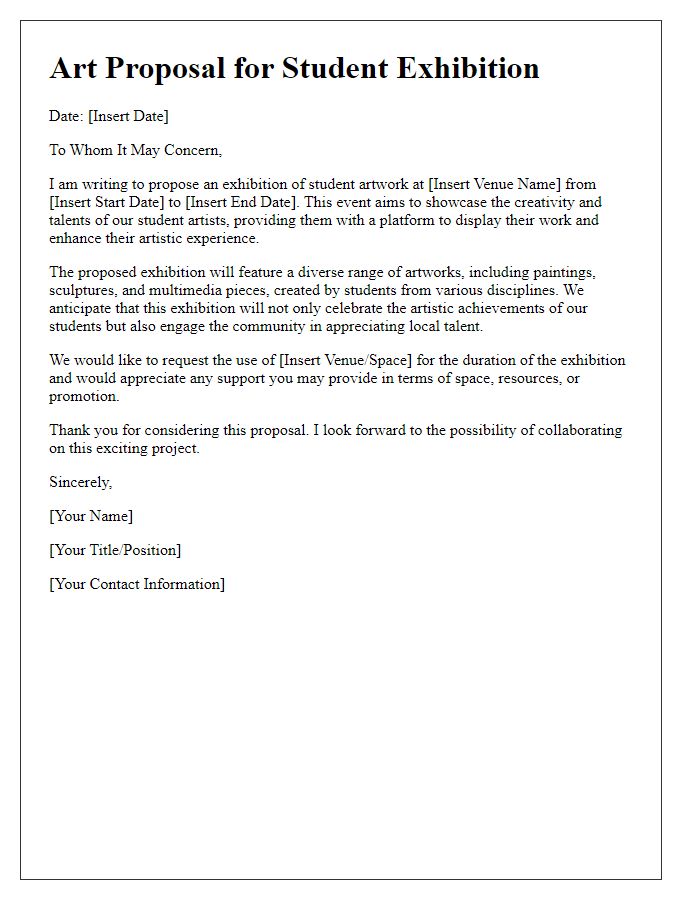Are you an artist ready to showcase your talent but unsure how to present your proposal? Writing a compelling letter is key to grabbing the attention of galleries and curators alike. In this article, we'll guide you through essential tips and creative ideas to help your art proposal stand out. So, let's dive in and discover how to craft a letter that not only highlights your work but also invites others to experience your artistic vision!

Clear Objective and Theme
An art exhibition proposal requires a well-defined objective and theme to engage the audience. The objective should outline the purpose of the exhibition, such as promoting local artists or exploring contemporary issues through visual art. The theme serves as a conceptual framework, guiding the selection of artworks that resonate with the central idea, whether it be environmental awareness, societal challenges, or cultural heritage. For instance, an exhibition titled "Echoes of Nature" might focus on works that reflect the beauty and fragility of the environment, featuring mixed media sculptures, vivid paintings, and immersive installations. Clear goals enhance the potential for collaboration with galleries, sponsors, and community organizations while attracting diverse audiences, facilitating conversations, and fostering a deeper appreciation for visual arts.
Artist Statement and Biography
An art exhibition proposal requires a comprehensive artist statement and biography that encapsulates the creator's inspiration, methodology, and background. The artist statement, typically ranging between 300 to 500 words, elucidates the artistic vision, themes explored, and techniques utilized in the work. It reflects the artist's philosophy, motivation, and emotional connection to the artworks. The biography should present a chronological account of the artist's life, including key milestones such as educational achievements from institutions like the School of the Art Institute of Chicago, significant exhibitions in renowned galleries like the Tate Modern, and any awards received such as the Fulbright Fellowship. Including a list of past exhibitions and collaborations with other artists or institutions adds depth to the proposal. The combination of these elements offers a comprehensive view of the artist's journey and creative expression, vital for engaging curators and art enthusiasts.
Detailed Project Description
An art exhibition proposal typically includes a detailed project description highlighting the core theme, artistic vision, and logistical requirements. The theme centers around the exploration of urbanism in contemporary life, focusing on the impact of rapid city development (over 3 million people annually worldwide) on social structures and individual identities. Artists involved will include local creators from urban centers such as New York, Tokyo, and Berlin, ensuring diverse perspectives. Proposed artwork formats include large-scale installations and mixed media pieces showcasing materials like found objects and digital media to create immersive experiences. The exhibition will take place in a prominent venue, such as the Museum of Modern Art in New York City, renowned for hosting innovative art events. The project timeline encompasses a five-month preparation period leading up to the launch on June 15, 2024, coinciding with the Summer Solstice and attracting significant visitor traffic. Essential logistics include securing funding through grants from art foundations and establishing partnerships with local businesses for sponsorship opportunities. The anticipated visitor engagement is projected at over 10,000 attendees during the first month, with extensive marketing strategies utilizing social media platforms and community outreach initiatives to maximize exposure.
Target Audience and Impact
The target audience for the art exhibition will primarily include local art enthusiasts, students from renowned institutions such as the School of Visual Arts (SVA) in New York City, and professionals from the creative industry, including graphic designers and curators. The exhibition aims to attract over 500 attendees over its two-week duration, fostering engagement through interactive workshops and guided tours. The impact of this event will extend beyond immediate viewers, aiming to deepen community appreciation for contemporary art, stimulate interest in local artists, and encourage dialogue surrounding current societal issues reflected in the artworks. Special outreach programs will be established for schools in the area, supporting educational initiatives and promoting youth involvement in the art world. Collectively, the exhibition aspires to create a lasting influence on participants and elevate the cultural significance of the local art scene.
Budget and Funding Requirements
An art proposal exhibition requires a clearly outlined budget and funding plan to ensure successful implementation. The total estimated budget may range from $10,000 to $50,000 depending on the scale of the exhibition, the venue (for example, a contemporary art gallery in New York City), and the number of works being displayed. Venue rental (approximately $2,000 to $7,000 for two weeks) is a major cost factor, alongside transportation of artworks, insurance ($1,500 to $3,000), and promotional materials ($500 to $2,000). Artist stipends may also be necessary, ranging from $1,000 to $5,000. Funding sources may include local arts grants, sponsorships from businesses, crowdfunding platforms, and ticket sales (anticipated revenue could be $3,000 to $10,000). A detailed financial plan that provides a breakdown of costs and projected income is essential for potential funders and stakeholders to evaluate the project's viability and impact.













Comments